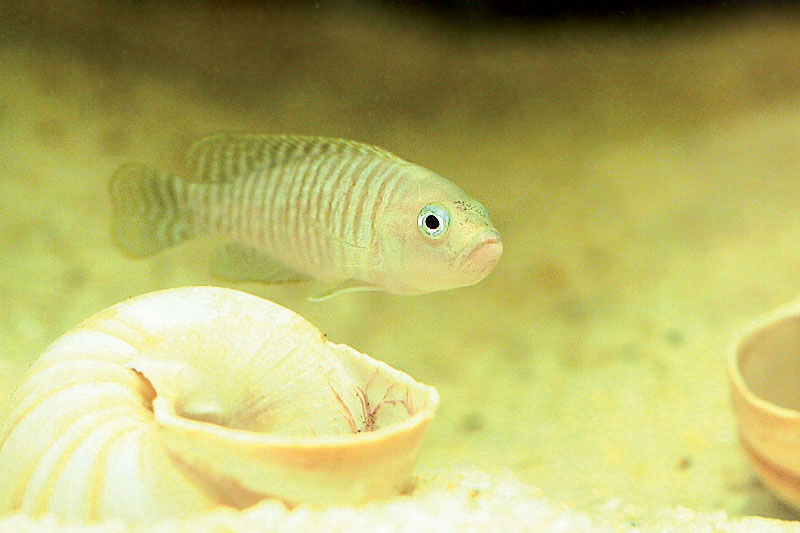Multies (‘Lamprologus’ multifasciatus)
 The female of my pair of 'Lamprologus' multifasciatus
When I initially set up this tank, I added an adult pair of 'Lamprologus' multifasciatus that I had recently bought at an auction. When asking on Cichlid-forum about the suitability of multies as tank mates for tropheus, several people advised me not to try this. As a result, I attempted to remove the multies. I had assumed this would be easy, since I could simply pick them up with the shell. This turned out not to be the case, since they left their shell as soon as I put them in the tank never to return to it. They far preferred to take up residence in the caves under the huge piece of driftwood, from which they were impossible to get out.
When I was in Germany for X-mas 2008, I visited Mal-Ta-Vi, a noteworthy importer and breeder of Rift Lake cichlids. When chatting with the owner, he mentioned that there are two types of multies in the hobby - one that lives in shells all the time, and one that moves into shells only when breeding. I had not heard this before, but from my experience I believe he was right, and my multies are of the second type.
I lost the male multi in the near tank disaster described on the page about my Eretmodus cyanostictus Burundi'. It was a surprise for me that the multi died as a result of poor water conditions while the usually much more sensitive tropheus survived. However, this particular multi had a deformity in form of a crooked head around the gill plates, which might be at least part of the explanation.
The female multi is still in the tank at the time of writing this (February 2009). She seems to have no trouble competing for food with the tropheus, and does not seem bothered by their boisterous behavior. If I can not catch her, maybe one day will succumb to the temptation of finding out first hand about the suitability of a colony of multies as tank mates for tropheus by finding her a mate.
The female of my pair of 'Lamprologus' multifasciatus
When I initially set up this tank, I added an adult pair of 'Lamprologus' multifasciatus that I had recently bought at an auction. When asking on Cichlid-forum about the suitability of multies as tank mates for tropheus, several people advised me not to try this. As a result, I attempted to remove the multies. I had assumed this would be easy, since I could simply pick them up with the shell. This turned out not to be the case, since they left their shell as soon as I put them in the tank never to return to it. They far preferred to take up residence in the caves under the huge piece of driftwood, from which they were impossible to get out.
When I was in Germany for X-mas 2008, I visited Mal-Ta-Vi, a noteworthy importer and breeder of Rift Lake cichlids. When chatting with the owner, he mentioned that there are two types of multies in the hobby - one that lives in shells all the time, and one that moves into shells only when breeding. I had not heard this before, but from my experience I believe he was right, and my multies are of the second type.
I lost the male multi in the near tank disaster described on the page about my Eretmodus cyanostictus Burundi'. It was a surprise for me that the multi died as a result of poor water conditions while the usually much more sensitive tropheus survived. However, this particular multi had a deformity in form of a crooked head around the gill plates, which might be at least part of the explanation.
The female multi is still in the tank at the time of writing this (February 2009). She seems to have no trouble competing for food with the tropheus, and does not seem bothered by their boisterous behavior. If I can not catch her, maybe one day will succumb to the temptation of finding out first hand about the suitability of a colony of multies as tank mates for tropheus by finding her a mate.
Leave a Reply
You must be logged in to post a comment.







